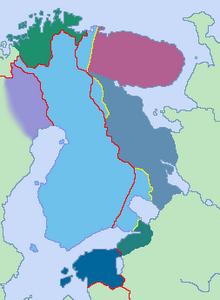
Back فنلندا الكبرى Arabic Вялікая Фінляндыя Byelorussian Gran Finlàndia Catalan Stor-Finland Danish Großfinnland German Grandfinnlando Esperanto Gran Finlandia Spanish Suur-Soome idee Estonian Suur-Suomi Finnish Grande Finlande French
This article includes a list of general references, but it lacks sufficient corresponding inline citations. (December 2014) |

Greater Finland (Finnish: Suur-Suomi; Estonian: Suur-Soome; Swedish: Storfinland) is an irredentist and nationalist idea which aims for the territorial expansion of Finland.[1] It is associated with Pan-Finnicism. The most common concept saw the country as defined by natural borders encompassing the territories inhabited by Finns and Karelians, ranging from the White Sea to Lake Onega and along the Svir River and Neva River—or, more modestly, the Sestra River—to the Gulf of Finland. Some extremist proponents also included the Kola Peninsula, Finnmark, the Torne Valley, Ingria, and Estonia.[2]
The idea of a Greater Finland rapidly gained popularity after Finland became independent in December 1917. The idea has lost support after World War II (1939–1945).
- ^ Kinnunen, Tiina; Kivimäki, Ville (25 November 2011). Finland in World War II: History, Memory, Interpretations. BRILL. p. 385. ISBN 978-90-04-20894-0.
- ^ Cite error: The named reference
Weisswas invoked but never defined (see the help page).
© MMXXIII Rich X Search. We shall prevail. All rights reserved. Rich X Search